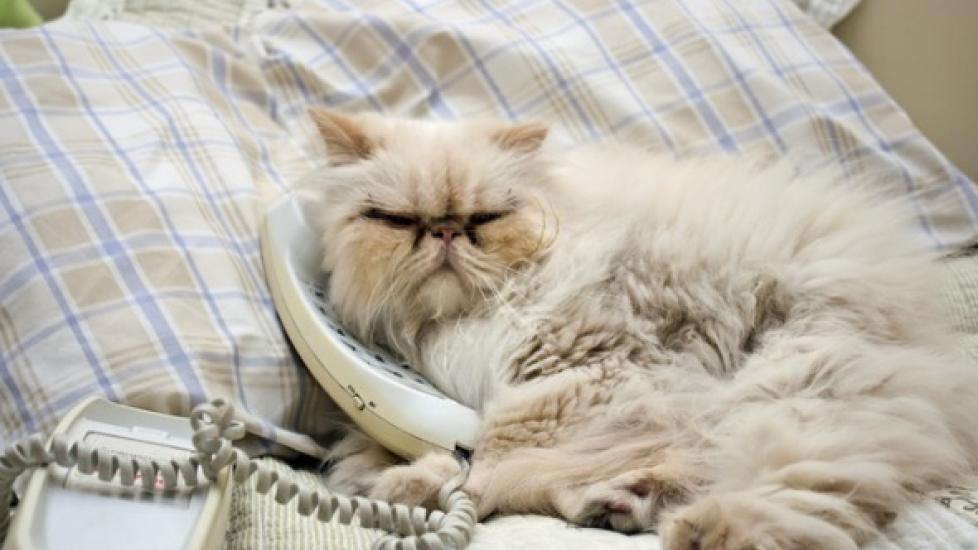Cat Language 101: How Do Cats Talk to Each Other?
Do cats talk to each other? Felines communicate with their peers through vocalizations, physical contact, visual cues and chemical cues. When communicating, cats exhibit subtle signaling compared to dogs due to their smaller features and quicker movements. If you blink your eye, you may have missed a crucial message from your cat.
If you want to know how cats communicate with each other, you must learn to read your cat’s body language.
Cat Language: Physical Cues
Pay special attention to the eyes, ears, tail and overall body posture. A cat that is feeling friendly and confident will hold his tail high in the air, his ears will be turned forward and his body will be tall.
If your cat is approaching another cat that she likes, the tip of the tail may be crooked forward. If your cat is feeling comfortable with the other cat’s presence, she may roll over enough to show her belly. This means she feels comfortable enough to show the other cat the most vulnerable part of her body. If your cat is uncertain or uncomfortable, she may crouch down, tuck her tail in along her body, and take a second to observe the cat.
Eye contact is another way cats communicate with each other. If your cat looks at another cat and blinks, she is telling them through cat body language that she is receptive to their approach and attention.
While interacting with another cat, if your cat looks away, licks her lips, crouches down, and pulls her ears to the side or flattens them on her head, this is an indication that your cat is feeling threatened and fearful.
When your cat feels threatened, she may display aggressive behavior. Showing aggression is one way of increasing distance from something your cat perceives as threatening. Cats who are hissing or growling with their backs and tails arched, their ears flattened against their heads, and their forelimbs close to their hind limbs may be on the verge of attacking. When agitated, many cats will also lash their tails from side to side.
Recommended Pet Products
Vocalization in Cat Language
Cats may use a meow or trill sound in greeting each other, but research has shown that cats tend to meow more when interacting with humans and do not use it often when they are interacting with each other. The meow appears to be a care-soliciting vocalization when directed towards people.
Purring is produced during inhalation and exhalation. Cats can purr when they are in contact with other cats, but also when they are contact with humans and objects. They purr when they are kneading blankets or rolling on the ground or rubbing on items.
While we assume that cats purr when they are happy, cats can also purr when they are not feeling well. Cat purring is a complex vocalization that needs to be studied further.
When a cat is feeling fearful, she may growl or hiss to tell the other cat to stay away or leave her alone. If the other cat does not listen and continues to approach, the first cat may escalate their vocalization to a snarl, spit or yowl prior to an attack. Cats can also howl when they are in distress.
Cat Communication Through Physical Contact
Cats can be very social. They greet each other through nose touches. They show affection by rubbing their heads against each other and along the sides of their bodies. Sometimes cats may even hook their tails and rub them together.
Cats typically do not rub against each other’s backs. This is why some cats do not tolerate long strokes along their backs. Their preferred contact areas are typically their head and along the sides of their bodies.
Chemical Signals and Cat Marking
When cats rub on each other and objects, they deposit pheromones and oils from the scent glands located on their foreheads, cheeks and chins. They also exchange scents when their bodies and tails rub against each other. Cats will also rub on prominent objects in the house to leave a scent trail and mark their territory.
Cats can also spray urine to mark their territory. It is not uncommon to see this behavior in cats who live outside or have access to the outdoors. However, spraying can sometimes occur inside the house. When this occurs, it may be in response to an outside cat being on the property or another stressor in your cat’s life.
Now that you have learned some cat language, take a minute to watch your kitties interact and see if you can decode their signals.
Featured Image: iStock.com/grecosvet
